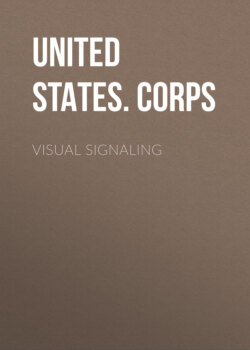Читать книгу Visual Signaling - United States. Army. Signal Corps - Страница 6
На сайте Литреса книга снята с продажи.
THE FLAG KIT.
ОглавлениеTable of Contents
Two kinds of flag kits, the 2-foot kit and the 4-foot kit, are issued by the Signal Corps.
The 2-foot kit.—This kit consists of one white and one red signal flag, two three-jointed staffs, and a suitable carrying case to contain the outfit. The white flag is made of white muslin 2 feet square, with an 8-inch turkey-red muslin center. The red flag is of similar size and material, the only difference being an alternation of colors in the body and center. The means of attachment to the staff consists of a loop at the center, and two ends of white tape at each edge, of the back of the flag body. The staff is made of hickory in three joints, each 23 inches long, and is assembled by telescoping into brass ferrules. Brass eyes are provided on the first and second joints to receive the tape ends at the edge of the flag. The carrying case, of convenient size and shape to contain the two flags and staffs complete, is made of 8-ounce standard khaki bound with leather and fitted with a shoulder strap.
The 2-foot kit is essentially a practice kit, although under favorable conditions of weather and terrain it may be used to advantage as a short distance service signaling outfit. Two of these kits are issued to each troop, battery, and company for the purpose of disseminating general instruction in military signaling throughout the army.
The 4-foot kit.—This kit is of essentially the same description as the 2-foot kit except as regards size. The flags are 3 feet 9 inches square with 12-inch centers and the staffs are considerably heavier, the joints being each 36 inches long. The 4-foot kit is the standard field flag kit and the range at which signals can be exchanged with it depends on a variety of factors, such as the condition of the weather, the location of stations, the proficiency of signalmen, etc. The speed for continuous signaling is seldom greater than five to six words per minute.
Care of flag material.—Signal flags should be examined at the close of drill or practice and repairs made to any rents or loose ties discovered. Flags, when soiled, should be thoroughly washed and dried in the sun. Signals made by clean flags are much more easily read than those made by dirty ones. Staffs should be handled with care, especially when jointing or unjointing. Care should be taken not to bruise the ends of the brass ferrules. If a ferrule becomes loose on a staff it should be tightened without delay.
Powers and limitations of flag signaling.—The advantages which may be claimed for this method of signaling are portability of apparatus, adaptability to varied weather conditions, and great rapidity of station establishment. The disadvantages are the lack of celerity of the signals, their impenetrability to dust or smoke, and the comparatively short ranges at which they can be read.
